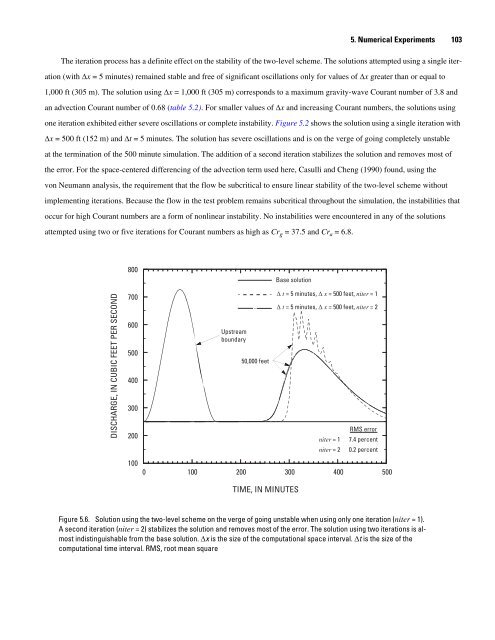A Semi-Implicit, Three-Dimensional Model for Estuarine ... - USGS
A Semi-Implicit, Three-Dimensional Model for Estuarine ... - USGS
A Semi-Implicit, Three-Dimensional Model for Estuarine ... - USGS
You also want an ePaper? Increase the reach of your titles
YUMPU automatically turns print PDFs into web optimized ePapers that Google loves.
5. Numerical Experiments 103<br />
The iteration process has a definite effect on the stability of the two-level scheme. The solutions attempted using a single iter-<br />
ation (with Δx = 5 minutes) remained stable and free of significant oscillations only <strong>for</strong> values of Δx greater than or equal to<br />
1,000 ft (305 m). The solution using Δx = 1,000 ft (305 m) corresponds to a maximum gravity-wave Courant number of 3.8 and<br />
an advection Courant number of 0.68 (table 5.2). For smaller values of Δx and increasing Courant numbers, the solutions using<br />
one iteration exhibited either severe oscillations or complete instability. Figure 5.2 shows the solution using a single iteration with<br />
Δx = 500 ft (152 m) and Δt = 5 minutes. The solution has severe oscillations and is on the verge of going completely unstable<br />
at the termination of the 500 minute simulation. The addition of a second iteration stabilizes the solution and removes most of<br />
the error. For the space-centered differencing of the advection term used here, Casulli and Cheng (1990) found, using the<br />
von Neumann analysis, the requirement that the flow be subcritical to ensure linear stability of the two-level scheme without<br />
implementing iterations. Because the flow in the test problem remains subcritical throughout the simulation, the instabilities that<br />
occur <strong>for</strong> high Courant numbers are a <strong>for</strong>m of nonlinear instability. No instabilities were encountered in any of the solutions<br />
attempted using two or five iterations <strong>for</strong> Courant numbers as high as Cr g = 37.5 and Cr a = 6.8.<br />
DISCHARGE, IN CUBIC FEET PER SECOND<br />
800<br />
700<br />
600<br />
500<br />
400<br />
300<br />
200<br />
100<br />
Upstream<br />
boundary<br />
50,000 feet<br />
Base solution<br />
Δ t = 5 minutes, Δ x = 500 feet, niter = 1<br />
Δ t = 5 minutes, Δ x = 500 feet, niter = 2<br />
RMS error<br />
niter = 1 7.4 percent<br />
niter = 2 0.2 percent<br />
0 100 200 300 400 500<br />
TIME, IN MINUTES<br />
Figure 5.6. Solution using the two-level scheme on the verge of going unstable when using only one iteration (niter = 1).<br />
A second iteration (niter = 2) stabilizes the solution and removes most of the error. The solution using two iterations is almost<br />
indistinguishable from the base solution. Δx is the size of the computational space interval. Δt is the size of the<br />
computational time interval. RMS, root mean square

















